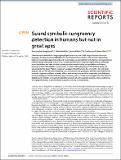Files in this item
Sound symbolic congruency detection in humans but not in great apes
Item metadata
| dc.contributor.author | Margiotoudi, Konstantina | |
| dc.contributor.author | Allritz, Matthias | |
| dc.contributor.author | Bohn, Manuel | |
| dc.contributor.author | Pulvermüller, Friedemann | |
| dc.date.accessioned | 2019-09-10T14:30:10Z | |
| dc.date.available | 2019-09-10T14:30:10Z | |
| dc.date.issued | 2019-09-03 | |
| dc.identifier | 261104191 | |
| dc.identifier | 0feb296d-f978-48f0-a9e1-9f60ad116a4b | |
| dc.identifier | 85071749643 | |
| dc.identifier | 000483700400038 | |
| dc.identifier.citation | Margiotoudi , K , Allritz , M , Bohn , M & Pulvermüller , F 2019 , ' Sound symbolic congruency detection in humans but not in great apes ' , Scientific Reports , vol. 9 , 12705 . https://doi.org/10.1038/s41598-019-49101-4 | en |
| dc.identifier.issn | 2045-2322 | |
| dc.identifier.other | RIS: urn:59480EC4A70D3FB0937D5223EFD698DA | |
| dc.identifier.other | RIS: Margiotoudi2019 | |
| dc.identifier.uri | https://hdl.handle.net/10023/18448 | |
| dc.description | This work was supported by the Deutsche Forschungsgemeinschaft (DFG, German Research Foundation) under Germany’s Excellence Strategy through EXC 2025/1 “Matters of Activity (MoA)” and by the “The Sound of Meaning (SOM)”, Pu 97/22-1,“Brain Signatures of Communication (BraSiCo)”, Pu 97/23-1, and “Phonological Networks (PhoNet)”, Pu 97/25-1. K.M. was supported by the Berlin School of Mind and Brain and by the Onassis foundation. M.A was supported by the “SOMICS” ERC Synergy grant (nr.609819). M.B was supported by the European Union’s Horizon 2020 research and innovation programme under the Marie Sklodowska-Curie grant agreement No 749229. | en |
| dc.description.abstract | Theories on the evolution of language highlight iconicity as one of the unique features of human language. One important manifestation of iconicity is sound symbolism, the intrinsic relationship between meaningless speech sounds and visual shapes, as exemplified by the famous correspondences between the pseudowords ‘maluma’ vs. ‘takete’ and abstract curved and angular shapes. Although sound symbolism has been studied extensively in humans including young children and infants, it has never been investigated in non-human primates lacking language. In the present study, we administered the classic “takete-maluma” paradigm in both humans (N = 24 and N = 31) and great apes (N = 8). In a forced choice matching task, humans but not great apes, showed crossmodal sound symbolic congruency effects, whereby effects were more pronounced for shape selections following round-sounding primes than following edgy-sounding primes. These results suggest that the ability to detect sound symbolic correspondences is the outcome of a phylogenetic process, whose underlying emerging mechanism may be relevant to symbolic ability more generally. | |
| dc.format.extent | 12 | |
| dc.format.extent | 1289441 | |
| dc.language.iso | eng | |
| dc.relation.ispartof | Scientific Reports | en |
| dc.subject | BF Psychology | en |
| dc.subject | NDAS | en |
| dc.subject.lcc | BF | en |
| dc.title | Sound symbolic congruency detection in humans but not in great apes | en |
| dc.type | Journal article | en |
| dc.contributor.sponsor | European Research Council | en |
| dc.contributor.institution | University of St Andrews. School of Psychology and Neuroscience | en |
| dc.identifier.doi | 10.1038/s41598-019-49101-4 | |
| dc.description.status | Peer reviewed | en |
| dc.identifier.grantnumber | 609819 | en |
This item appears in the following Collection(s)
Items in the St Andrews Research Repository are protected by copyright, with all rights reserved, unless otherwise indicated.

